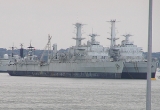
Fearless class landing platform dock
Encyclopedia
The Fearless class amphibious assault ships were the first purpose built amphibious warfare vessels in the Royal Navy
. The class comprised only two ships: and .
Designed as Landing Platform Docks, they were designed to transport and land troops by sea either using Landing Craft Utility
or helicopters. As constructed, the ships have an internal dock that is accessed via the stern - while in port, vehicles can simply drive up the stern ramp and into the internal vehicle decks. At sea, the ships could partially sink themselves at the stern, flooding the internal dock and allowing landing craft to come right up to the edge of the vehicle deck.
Each ship carried four LCUs in the stern dock, with four more smaller landing craft
on davits on the superstructure. They provided accommodation for up to 400 troops (though if no vehicles were carried, up to 700 could be accommodated using the vehicle decks and corridors).
to enter the fleet. The Fearless class were the last steam-powered surface vessels in Royal Navy service (nuclear submarines use a steam turbine-electric drive).
The successful deployments of the two ships, with the flexibility their configuration provided, meant that they have now been replaced by two new LPD ships of the class. These LPD have been developed and commissioned despite the development of the Helicopter Carrier which itself has considerable Assault landing capability demonstrating the importance of the options that a dock provides.
Royal Navy
The Royal Navy is the naval warfare service branch of the British Armed Forces. Founded in the 16th century, it is the oldest service branch and is known as the Senior Service...
. The class comprised only two ships: and .
Designed as Landing Platform Docks, they were designed to transport and land troops by sea either using Landing Craft Utility
Landing Craft Utility
The Landing Craft Utility is a type of boat used by amphibious forces to transport equipment and troops to the shore. They are capable of transporting tracked or wheeled vehicles and troops from amphibious assault ships to beachheads or piers....
or helicopters. As constructed, the ships have an internal dock that is accessed via the stern - while in port, vehicles can simply drive up the stern ramp and into the internal vehicle decks. At sea, the ships could partially sink themselves at the stern, flooding the internal dock and allowing landing craft to come right up to the edge of the vehicle deck.
Each ship carried four LCUs in the stern dock, with four more smaller landing craft
Landing craft
Landing craft are boats and seagoing vessels used to convey a landing force from the sea to the shore during an amphibious assault. Most renowned are those used to storm the beaches of Normandy, the Mediterranean, and many Pacific islands during WWII...
on davits on the superstructure. They provided accommodation for up to 400 troops (though if no vehicles were carried, up to 700 could be accommodated using the vehicle decks and corridors).
Service
Intrepid was put into extended reserve in 1991, effectively removing her from active service. While in this state, she was used as a source of spares to maintain Fearless. Intrepid was finally withdrawn from service in August 1999. Fearless was kept in service, and continued to be deployed in concert with until the end of 2002, when she too was withdrawn from service, ready for the Albion classAlbion class landing platform dock
The Albion class is a class of landing platform dock, and are the newest amphibious assault vessels in the Royal Navy fleet. The class consists of two vessels, and and they were ordered in 1996 under a programme known as LPD to replace the aging Fearless class...
to enter the fleet. The Fearless class were the last steam-powered surface vessels in Royal Navy service (nuclear submarines use a steam turbine-electric drive).
The successful deployments of the two ships, with the flexibility their configuration provided, meant that they have now been replaced by two new LPD ships of the class. These LPD have been developed and commissioned despite the development of the Helicopter Carrier which itself has considerable Assault landing capability demonstrating the importance of the options that a dock provides.
Ships
| Pennant Pennant number In the modern Royal Navy, and other navies of Europe and the Commonwealth, ships are identified by pennant numbers... |
Name | (a) Hull builder (b) Main machinery manufacturers |
Laid down | Launched | Accepted into service | Commissioned | Estimated building cost |
|---|---|---|---|---|---|---|---|
| L10 | Fearless HMS Fearless (L10) HMS Fearless was a Royal Navy ship which served from 1965 until 2002. One of two from the Landing Platform Dock class she was based in HMNB Portsmouth and saw service around the world over her 37 year life... |
(a) Harland & Wolff Ltd, Belfast (b) English Electric Co Ltd, Rugby (steam turbines) (b) David Brown & Co Ltd, Huddersfield (gearing) |
25 July 1962 | 19 December 1963 | November 1965 | 25 November 1965 | £11,250,000 |
| L11 | Intrepid HMS Intrepid (L11) HMS Intrepid was one of two Fearless class amphibious warfare ships of the Royal Navy. A Landing Platform Dock , she served from 1967 until 1999... |
(a) John Brown & Co Ltd, Clydebank (b) English Electric Co Ltd, Rugby (steam turbines) (b) David Brown & Co Ltd, Huddersfield (gearing) |
19 December 1962 | 25 June 1964 | March 1967 | 11 March 1967 | £10,300,000 |

